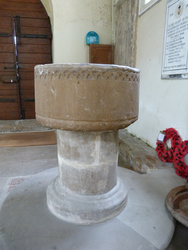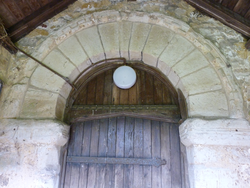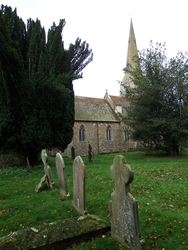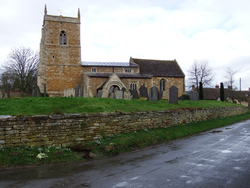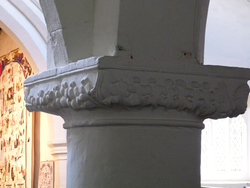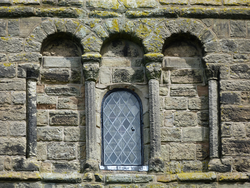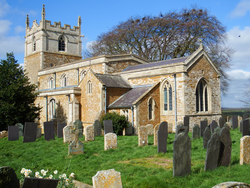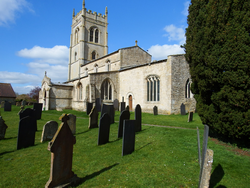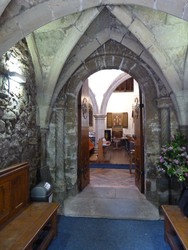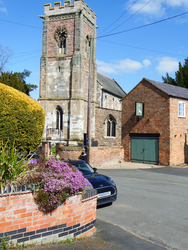
The Corpus of ROMANESQUE SCULPTURE in Britain & Ireland
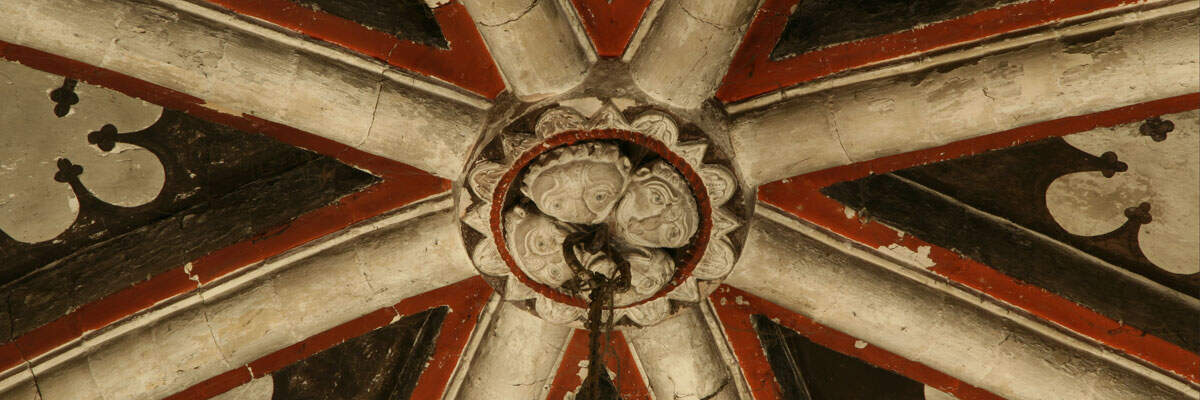
Leicester (now)
Parish church
Lockington is a village in the extreme NW of the county,. The Derbyshire border is a mile to the N, and Derby, 8 miles to the NW, is the nearest major town. The village is small and attractive with the church close to its centre. It consists of a 13thc nave and chancel with arcades of the same period, widened in the 14thc. The S porch was rebuilt in 1946. The W tower belongs to the later 14thc or early 15thc, and a clerestorey was added to the nave c.1500. The earliest part of the fabric is the N aisle doorway of the early 13thc, but there are Norman remains in the form of part of a 12thc doorway rebuilt inside the N aisle, a font and a fragment of a billet label reset on the exterior, in the angle between the chancel and the S aisle.
Parish church, formerly chapel
Little Stretton is a small village in the Harborough district of Leicestershire, 6 miles SE of Leicester. The church stands to the N of the road through the village, and is a small ironstone building with a low nave and chancel in one, a S porch and a W tower. The S doorway and a plain blocked N doorway are 12thc. The Purbeck font is 13thc.
Parish church
South Kilworth is a small village in the Harborough district of south Leicestershire. within a mile of the Northamptonshire border to the S, and 8 miles SW of Market Harborough. The church consists of a nave wth N and S aisles, a S porch a SW tower with a broach spire and a chancel. The earliest fabric is in the late-12thc N arcade. The tower is 15thc and the chancel is 19thc, replacing one of 1799. The S arcade is also 19thc. There was a major restoration in 1868-69 by G F Bodley in which the chancel, N aisle and the medieval S aisle were replaced. The church is of coursed rubble with ashlar dressings. Romanesque features describe her are the N arcade and a late-12thc font.
Parish church
Bringhurst is a small village in the Harborough district of SE Leicestershire, close to the borders of Northamptonshire and Rutland. The nearest large town is Corby (Northants), 3 miles to the SE. Market Harborough is 7 miles to the SW. The village stands on a hill with the church in the centre, and consists of a 2 bay aisled nave with a S porch, a W tower and chancel. The earliest feature, and the only one relevant to the Corpus is the late Romanesque N arcade. The church is of coursed rubble with ashlar dressings and a Collyweston stone roof. It was restored by Ewan Chistian (a drab restoration according to Pevsner) in 1862-63.
Parish church
An interesting unrestored church consisting of a nave, N and S aisles, chancel, N chancel chapel and W tower. Most of this work is 13thc, excluding the upper part of the tower, windows in the N aisle and the chapel. There is a stiff-leaf capital of c. 1200 in the N arcade and two re-set carved corbel stones, one in the S chapel and one in the N chancel chapel.
Parish church
Higham on the Hill is a village in the Hinckley and Bosworth district of SW Leicestershire, adjacent to the Warwickshire border and 2.5 miles NW of Hinckley. It consists now of a Norman W tower to which was added a nave by Henry Couchman of Warwickshire in 1791, a S aisle and porch by Ewan Christian in 1854 and a chancel by R. Jennings in 1870. It is clear from a large blocked arch in the W wall of the tower that this was originally central. It is an elaborate structure with corbel tables on all four faces, bell-openings and wall arcading.
Parish church
Sproxton is a village in the Melton district of NE Leicestershire, 2 miles W of the Lincolnshire border and 7 miles NE of Melton Mowbray. The church stands on the road out of the village to the N, and is an ironstone building consisting of a nave with a S aisle and S transept, chancel with a S chapel and a W tower. The tower is 13thc for the most part, with a late-14thc upper storey with battlements and pinnacles of limestone. The church was restored in 1882-83 by Woodyer who rebuilt the top of the tower, the porch, the S aisle, the chancel arch and the additions to the S of the chancel. Norman evidence of an earlier building survives in the form of chevron voussoirs re-used on the exterior and the capitals re-used by Woodyer in the rebuilt chancel arch. In 2017 a 12thc grave slab was discovered when a new drain was being installed and this is displayed in the church.
Parish church
Stonesby is a small village in the Melton district of NE Leicestershire, 5½ miles NE of Melton Mowbray. St Peter's is on the N side of the main street, and consists of an early-14thc nave, aisles and chancel, the last refaced in in 1667, and a late-14thc W tower. In the chancel is a S doorway, 12thc in origin but retooled. There is a fine 12thc font but this is completely retooled. The church is of limestone and some ironstone and was restored by R W Johnson in 1874-75.
Parish church
The name of the village was changed to Quorn from Quorndon in 1889 to avoid postal confusion with Quarndon (Derbyshire). Quorn is a large in the Charnwood district of N Leicestershire, 2 miles SE of Loughborough. The church is at the N end of the village and is a Mountsorrel granite rubble building consisting nave, W tower and chancel. The nave has a N aisle, and a S chapel (the Farnham chapel) alongside the W end. The E part of the Farnham Chapel is a porch covering a 12thc doorway, with a Priest's Room above. The chancel has a N organ room. Apart from the surviving doorways, the fabric is 14thc and later. The 14thc N aisle was widened in 1842 by William Parsons. The church was restored by Ewan Christian in 1865-66, and the organ room was added in 1897 by W. D. Caroe. The only 12thc sculpture is on the S nave doorway, but there is also a plain 12thc Priest's doorway.
Parish church
Seagrave is a village in the Charnwood district of Leicestershire, 5 miles E of Loughborough. The church is at the E end of the village and is of granite rubble with stone dressings. It consists of a chancel, aisled nave with N and S porches and a 3-storey W tower. The earliest fabric is in the 13thc N arcade and N doorway, and the chancel was rebuilt as part of E. H. Lingen Baker's 1890-91 restoration. The font is the only Romanesque feature.
